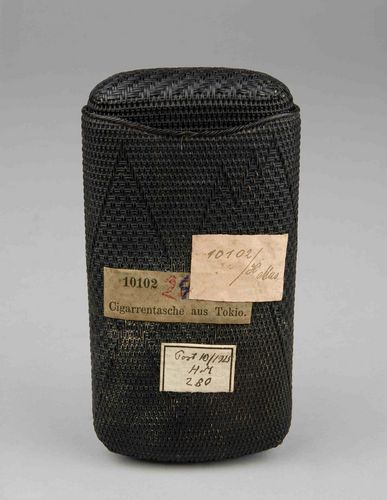The Database
The Japanese Meiji government (1868–1912) sent around 6,800 exhibits to the World Exhibition in Vienna in 1873. Part of the research project is to record objects that still exist today, both in Viennese museum collections and in publicly accessible collections worldwide, and to link them virtually with their historical catalogue information.
The database is available in three languages: German, Japanese and English.
The information on the individual objects is summarized from Japanese and German sources, compared with each other and thus made easier to find digitally. The aim is to enable further re-use and research of the data in accordance with the FAIR principles. Object histories on Japan's economy, art and culture in exchange with the West will be added to the online database in the future.
The official exhibition catalogue of the Japanese commission in German was used as the basis and framework for the database: Catalog der kaiserlichen japanischen Ausstellung 1873, Vienna 1873. A Japanese original version is still not known today. However, there are many administrative lists that were compiled by members of the Japanese exhibition commission in 1872, 1873 and later. They are now in the Tokyo National Museum and other institutions in Japan.
Some of the original Japanese material was published by the Tokyo National Cultural Research Institute in 1997: 明治期万国博覧会美術品出品目録 / 東京国立文化財研究所美術部 (Meijiki bankoku hakurankai bijutsuhin shuppin mokuroku / Tōkyō Kokuritsu Bunkazai Kenkyūjo Bijutsubu hen, Catalog of artworks exhibited at the Meiji Period World's Fair / compiled by the Art Department of the National Cultural Properties Research Institute, Tokyo), 東京: 中央公論美術出版, 平成 9 (Tōkyō: Chūō Kōron Bijtusu Shuppan, Heisei 9 [1997. 5]).
This publication is based on the work of: Yokomizo 1993–1994
横溝廣子Yokomizo, Hiroko [黒川廣子 Kurokawa, Hiroko], ウイーン万国博覧会出品目録草稿. 美術工芸編 (Draft for Japanese Catalogue of Vienna Universal Exhibition. Sections of Arts and Crafts, Part I–III), in: 美術研究 (The Bijutsu Kenkyu. The Journal of Art Studies, 編集. 東京国立文化財研究所美術部 (Department of Fine Arts, Tokyo National Research Institute of Cultural Properties), 通号 357, 1993.7, p. 260–269, 通号 358, 1993.12, p. 329–355, 通号 359, 1994.3, p. 30–68.
If available, historical images from a photo album from 1872, current data on location/whereabouts in current museum collections, inventory number, photograph, etc. are added to the data.
Project description:
https://repository.khm.at/viewer/japan/weltausstellung/1873
Notes on using the database:
https://repository.khm.at/viewer/japan/weltausstellung/1873/info
Here is a tabular overview of the available data material for each group.
Exhibition of the Japanese Department 1873:
| Gliederung der Weltausstellung 1873 | Katalognummern | aus dem Japanischen transkribiert |
| Gruppe I. Bergbau und Hüttenwesen | 357 | nicht transkribiert |
| Gruppe II. Land- und Forstwirtschaft, Wein- und Obstbau und Gartenbau, landwirtschaftliche Maschinen | 604 | nicht transkribiert |
| Gruppe III. Chemische Industrie | 202 | nicht transkribiert |
| Gruppe IV. Nahrungs- und Genussmittel als Erzeugnisse der Industrie | 562 | nicht transkribiert |
| Gruppe V. Textil- und Bekleidungs-Industrie | 1674 [1566] | nicht transkribiert |
| Gruppe VI. Leder- und Kautschuk-Industrie | 106 | transkribiert |
| Gruppe VII. Metall-Industrie | 748 | transkribiert |
| Gruppe VIII. Holz-Industrie | 618 | transkribiert |
| Gruppe IX. Stein-, Thon- und Glas-Industrie | 384 | transkribiert |
| Gruppe X. Kurzwaaren-Industrie | 635 | transkribiert |
| Gruppe XI. Papier-Industrie | 394 | nicht transkribiert |
| Gruppe XII. Graphische Künste und gewerbliches Zeichnen | 15 | transkribiert |
| Gruppe XIII. Maschinenwesen und Transportmittel | 4 | nicht transkribiert |
| Gruppe XIV. Wissenschaftliche Instrumente | 19 | nicht transkribiert |
| Gruppe XV. Musikalische Instrumente | 38 | transkribiert |
| Gruppe XVI. Heereswesen | / | / |
| Gruppe XVII. Marinewesen | 18 | nicht transkribiert |
| Gruppe XVIII. Bau- und Civil-Ingenieurwesen | 99 | nicht transkribiert |
| Gruppe XIX. Das bürgerliche Wohnhaus mit seiner inneren Einrichtung und Ausschmückung | 71 | transkribiert |
| Gruppe XX. Das Bauernhaus mit seiner Einrichtung und seinen Geräthen | 3 | transkribiert |
| Gruppe XXI. Nationale Hausindustrie | / | / |
| Gruppe XXII. Darstellung der Wirksamkeit der Museen für Kunstgewerbe | / | / |
| Gruppe XXIII. Kirchliche Kunst | 22 | transkribiert |
Gruppe XXIV. Objekte von Kunst und Kunstgewerbe früherer Zeiten | 47 | transkribiert |
| Gruppe XXV. Bildende Kunst der Gegenwart | 48 | transkribiert |
| Gruppe XXVI. 1. Erziehungs-, Unterrichts-, und Bildungswesen | / | / |
| Additionelle Ausstellung der Frauenarbeiten | / | / |
| Additionelle Ausstellung: Pavillon des Kindes | [?] | / |
| Additionelle Ausstellung: Geschichte der Gewerbe und Erfindungen | / | / |
| Additionelle Ausstellung: Geschichte der Preise | / | / |
| Additionelle Ausstellung: Abfallsverwerthung | / | / |
| Additionelle Ausstellung: Darstellung des Welthandels | [?] | / |
| gesamt 6.560 |













